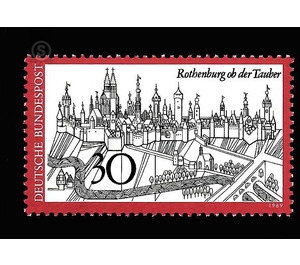tourism - Germany / Federal Republic of Germany 1969 - 30 Pfennig
Theme: Architecture
| Country | Germany / Federal Republic of Germany |
| Issue Date | 1969 |
| Face Value | 30.00 |
| Color | black grey red |
| Perforation | K 14 |
| Printing Type | Intaglio and offset printing |
| Stamp Type | Postage stamp |
| Item Type | Stamp |
| Chronological Issue Number | 493 |
| Chronological Chapter | GER-BRD |
| SID | 797559 |
| In 77 Wishlists | |
In the Federal Republic of Germany, there are a large number of popular and much visited tourist resorts. Making them known by the stamp is a much-discussed concern whose implementation has so far failed on many grounds. The first result of a new attempt is now available. It has managed to show Rothenburg ob der Tauber as it presents itself to the visitor today. At the same time, the depiction of the overall picture gives an impression of the historical development of the city, which was granted city rights in 1172 by Emperor Frederick I Barbarossa. In 1274 it was granted by the Emperor Rudolf I, the imperial freedom, which lasted until the Peace of Lunéville in 1802. The development of Rothenburg ob der Tauber into a tourist resort began at the beginning of this century. It is the epitome of medieval urban romance. The reputation of its sights has penetrated the world.


